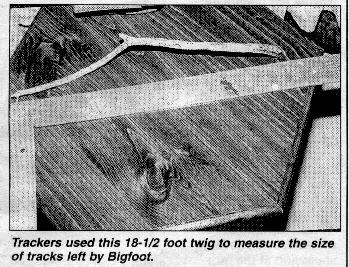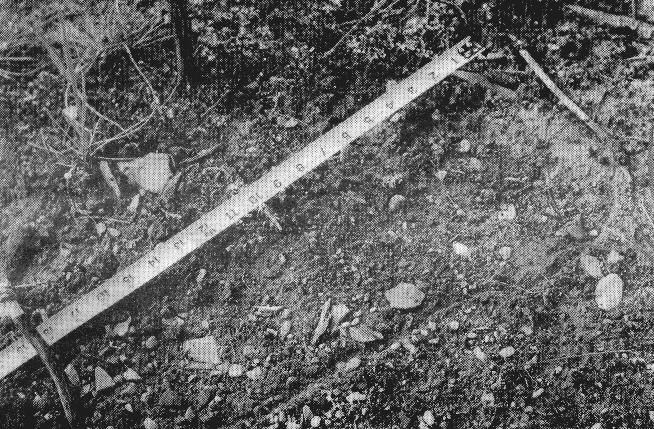Our Great Outdoors [newspaper insert]
The Standard, Ontario Canada
By Bruce MacKinnon, Osprey Media Group
Wednesday, March 27,
2002 -
Pg 14-31
 Apparently
they grow everything bigger on Ontario's Northern coast. The black flies
are meaner, mosquitoes bigger and thirstier, fish are as big as beluga
whales and there is something with really big feet.
Apparently
they grow everything bigger on Ontario's Northern coast. The black flies
are meaner, mosquitoes bigger and thirstier, fish are as big as beluga
whales and there is something with really big feet.
Some call it a Sasquatch, some call it smelly, some say it's very big, but all will agree it has big feet. With. 45-centimetre long and 15-centimetre wide footprints and a two-metre gait to prove it, residents of Peawanuck are just calling -it Bigfoot. Opinion is divided between those who have seen the tracks and the Algoma and Laurentian University anthropologists who say it's unlikely to exist. "I didn't believe it at first but now, I really believe all the reports about the creature," said Paul Koostachin, taxi driver and tracker. "After seeing the prints, I believe."
Attention focused
on Peawanuck early in June 2001 when Sam Nanokeesic, an employee at the
medical station was struck by a 40 cm stick while driving his ATV
on an empty road to the airport just outside of town. A foul odour ae end of the stick made him curious. Inspection of the woods nearby
revealed 45 centimetre tracks all over the place, he said.
 "We
saw where it had been standing behind trees near the road and more footprints
leading away from the area in a straight line, crossing the end of the
runway, heading towards the rock cliffs a few kilometres away," said
Nanokeesic. "It must have thrown the stick at me thinking I was
too close, trying to scare me off. It worked."
"We
saw where it had been standing behind trees near the road and more footprints
leading away from the area in a straight line, crossing the end of the
runway, heading towards the rock cliffs a few kilometres away," said
Nanokeesic. "It must have thrown the stick at me thinking I was
too close, trying to scare me off. It worked."
It's obviously very smart and actively stays out of sight, even though these tracks are within ten metres of a bush trail," said Tracker and guide Fletcher "Red" Mack. "This is not friendly terrain to be walking in," said Mack, waving away swarms of black flies. "It is obvious very large and heavy more than 220 kilograms, because of the depth of the prints and it appears to have a gait of 1.5 - 2.1 metres. The prints were still 5 centimetres deep in lichen and hard moss, after three weeks.
Mack, a 100-kilogram person, tried to make prints as deep but could only make impressions two centimetres deep. "It is frightening the size of it and how smart it is," said Mack. "No one here really wants to track it; they want to be able to come home."
Not all the residents feel the same way. Brian Hunter, a band worker and tracker-hunter said finding the quick moving target even in sparsely wooded areas like Peawanuck, would be a difficult task from the ground. " I'd love to hunt it but after a day, it's too late to find it. It would move too far away, with its gait of 1.5 - 2.2 metres," he said. "It has to be smart like a wolverine, and smarter than a chimp or ape since it travels from blind to blind, always staying hidden."
The general consensus is the large visitor is spending its summer vacations in the far north migrating from the deeper cover of dense forests in the central part of Northern Ontario or Manitoba where is hibernates during the winter.
The lack of scat, bones, tools and food remnants makes its existence unlikely, said Dr. Pat Julig, professor of archaeology and anthropology at Laurentian University in Sudbury. "For a group of humans to survive, you need at least 250 and with a Bigfoot, even if you had only 50 to 100, they'd have been found by now," he said. "You just couldn't have two or six, unless they are on the verge of extinction." A more likely explanation to Julig is that a lone Native, living in the wilderness wearing large animal skin boots filled with grass for insulation, is responsible. "I'd love to find one but if you look at the probabilities, it's not likely," he said.
"In every culture there's always the concept of the boogey man, monsters and spirits to keep people in line, so every culture has reports of something some people want to see.
Dr. Akram Rajput, professor of anthropology and sociology at Algoma University College in Sault Ste.Marie agree, but added that even in the deepest forest and jungles, scatological and other scientific evidence can be found of even the rarest of species.
"Since a Bigfoot isn't likely to live thousands of years, there has to be babies, skeletons and a colony somewhere," he said. "Since the forest of Northern Ontario are thinner, evidence would be easier to find. "We have to look at the many factors to prove the Bigfoot theory, so it's a hypothesis still in need of scientific evidence.
Ontario Ministry of Natural Resources (MNR) district supervisor Rick Tapley also discovered and took pictures of tracks, at an abandoned radar station about 80 kilometres from Peawanuck. He too was at a loss to explain what made such huge prints in an isolated area. "I found the large prints in the ground near the site and there is no way they are a hoax. It's too far from anywhere and we had to fly in by helicopter said Tapley.
Tapley admitted the MNR doesn't really want to find the source of the mystery due to budget fears. "It would cost a fortune to find this creature, up here in this terrain and if we did, we'd have to protect it as an endangered species," he said. "In this park, it's already in a protected zone." If there is indeed a Bigfoot like creature in the far north, it is likely not alone. "It's obvious there must be more than one, at lease a male and a female in order for it to sustain life for so many years." said Tapley. "It probably migrates but has a family hidden somewhere."
There have been 16 reported sightings of a Bigfoot in Ontario to date and other signs like footprints have been numerous. There has been discrepancies in print sizes from 35-45 centimetres in length, denoted a male and a female, said John Wabano, Peawanuck Band Councilor.
"It's tracks have been seen in recent years and many times in the last 30 to 40 years, with stories about something Bigfoot like in our folklore dating back to before European contact," said Wabano. The stories, especially those told during the last 30 years have told of a large hairy beast walking upright, smelling bad and being very shy. It or they have never been documented to harm humans and usually tracks have been the only clue to their presence. It goes out of its way not to cross open territory and only crosses rivers at night, Wabano said.
In recent years, several bush pilots flying low near Fort Severn have reported seeing a large black hairy biped beside a lake and disappear into the bush when they turned back.
To Mike Leahy of Kirkland Lake, a 27-year veteran prospector in Northern Ontario, just because he hasn't see tracks or other evidence doesn't prove something doesn't exist. "I've been all over James Bay lowlands and it is uninhabited land so vast and uninviting, only a few hunters living in the North have touched a tiny portion of the land," he said. "What hasn't been fished or hunted tends to grow large with little competition."
While some may laughingly call the mysterious visitor "Sasquatch," Northern Natives are unwilling to talk openly of such things. They prefer little attention and so were unlikely to make up the stories, said Wabano. What can't be explained isn't necessarily untrue.
Since Mr. Bigfoot
didn't hand around to be interviewed, all we have are his footprints to
go by. There are just too many tracks to be easily explained away. Whatever
you call it, it sure has big feet!
- ---
Back to Newspaper & Magazine Articles
Main
Back to stories?
Copyright Law as educational material without benefit of financial gain.
http://www4.law.cornell.edu/uscode/17/107.html
This proviso is applicable throughout the entire website.